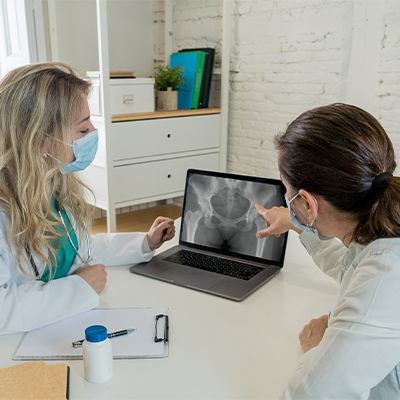Minor Sport &
Physical Injuries
Minor Sport and
Physical Injuries
There are two types of sport and physical injuries: acute injuries that happen suddenly, and chronic injuries that develop over time.
While there is no way to prevent all muscular injuries, there are some things you can do to reduce your risk. Injuries caused by overuse and straining can often be prevented by doing pre-and-post stretching before doing strenuous activities, and by taking a break when your body needs to rest.
It is also important to make sure you have proper protective gear when participating in a sport or working around the house. Make sure that protective gear is in proper working order. Also ensure you are adequately hydrated before, during, and after exercising. Still, even with all of these precautions, injuries will and do occur. When they do, our primary care providers are here for you.

Here are some of the most common and frequent physical injuries:
- Achilles tendinitis. The Achilles tendon is the strong, cord-like tissue that connects your calf muscle (the back of your lower leg) to your heel. It is the largest tendon in your body and is essential for walking and running. Achilles tendinitis is a common injury that can be caused by not stretching enough before use, not wearing the right shoes, or by suddenly becoming much more active. If your heel or calf hurt when you walk or run, if you have swelling in the heel or calf area, or if these areas are warm to your touch, you may have Achilles tendinitis. This injury can come on suddenly or over time and can become chronic without proper attention.
- Broken bone. This is also known as a bone fracture and occurs when there is sudden strong force upon a bone causing it to crack, fracture, or shatter. Symptoms include sudden acute pain, swelling, numbness, and tenderness around the bone area. You may not be able to move the area impacted. These injuries are acute, and the bone needs to be set, stabilized, and in some cases surgically put back together. An orthopedic specialist needs to be seen for any and all suspected fractures.
- Dislocations. Dislocations occur when the ends of your bones move out of their normal locations. These injuries are common in contact sports such as basketball, soccer, and football. Symptoms include intense pain, swelling, and an inability to move the area affected. An orthopedic specialist needs to be seen for dislocations.
- Jumper’s knee. Also known as patellar tendinitis, jumper’s knee happens when there is inflammation or an injury to the tissue that connects your kneecap and thigh muscles to your shin bone. Sports that require a lot of jumping, like basketball and volleyball, can cause this injury. Also, people who are overweight and play on hard surfaces are at risk. Symptoms include knee pain when jumping (usually just below the kneecap); weakness in the knee while jumping, climbing stairs, or kneeling. These injuries can be both chronic or acute.
- Ulnar collateral ligament injury and little league elbow. These two injuries happen from overuse of the arm. Little league elbow is a common injury of adolescent baseball players who stress their elbows with too much throwing. Ulnar collateral ligament injury is more common in adults. Symptoms of these injuries include pain in the inside of the elbow, especially when throwing. This is a chronic injury.
- Rotator cuff injuries. These injuries happen in the area inside your shoulder known as the rotator cuff, which assists your shoulder in movement and stability. Overuse actions done during swimming, tennis, or baseball can cause swelling in the shoulder area, pain when your arm is lifted, and pain when you reach behind your back. Rotator cuff injuries are chronic.
- Runner’s knee. Runner’s knee is common injury with a lot of runners, walkers, and bikers. It is another repetitive-motion injury but it can also be triggered by knee trauma, such as a hard hit to the knee. Symptoms include pain behind the kneecap, especially when the knee is bent. The area might be swollen, or you may feel a grinding feeling when you bend your knee. This injury can be both chronic and acute.
- Shin splints. Shin splints happen when the muscles and tendons around the area in front of your lower legs below your knees (your shins) become inflamed. This injury is common among runners and basketball players. The main symptom is shin pain while playing your sport. The pain usually goes away with rest. This injury is usually acute.
- Sprains. Sprains are one of the most common of physical and sports injuries. It is a stretch or tear of a ligament near a joint such as an ankle, wrist, or knee. Sprains are usually caused by a twisting or falling motion and can be mild or severe depending on whether the ligament is stretched or torn. Symptoms are pain, swelling (sometimes severe), and bruising. You may not be able to apply weight to your joint without feeling acute pain. These injuries are acute.
- Strains. Strains affect muscles, not ligaments, as sprains do. Strains occur when you stretch or tear muscle tissue by overextending it. While mild strains can be caused by repetitive motion, acute strains usually happen when running, jumping, lifting or quickly changing directions. You are more at risk for strains in cold weather. Symptoms are sudden pain accompanied by an immediate limited range of motion in the affected area. These injuries can be acute or chronic.
- Tennis elbow. This injury, often afflicting golfers and tennis players, is a painful condition caused by the overuse of the elbow. The pain manifests on the outside of the elbow and is caused by inflammation in the tendons. Other symptoms of tennis elbow include weakness, especially when you try to grip things. This injury can be chronic.
When You Experience an Injury, Follow These Steps:
- Stop. Stop your activity right away when you incur an injury or feel sudden pain. Depending on the injury, you could cause more damage by continuing your activity and trying to ignore the pain.
- Ice. Put ice on your injury when it occurs to help with pain and swelling.,15 to 20 minutes every four hours or so.
- Compression. Keeping pressure on the injured site will also help with swelling and provide additional support. An elastic medical-grade bandage can work well, wrapped tightly but not so tightly as to cut off circulation.
- Elevate. Prop up the affected area higher than your heart to rest the area and reduce swelling.
- Rest. A day or two of rest may be all you need for recovery, but sometimes an injury requires much more. For injuries affecting your legs, knees, or ankles, you might need to stay off your feet or obtain crutches to avoid putting weight on the injured body part.
Joint Injections
A joint injection is a non-surgical procedure that applies a solution of anesthetic and corticosteroid directly into damaged or painful joint tissue. This can provide fast relief needed for pain reduction and improvement in your range to allow you to participate in physical therapy exercises needed to return the body to a healthier and more balanced condition.
Sometimes joint injections can rectify an injury fully. But often physical therapy and exercises, and in some cases, surgery, are implicated. Your primary care doctor will assess and monitor your joint health and work with you to achieve full recovery or the best results possible.
When to See Your Provider for a Minor Injury or Sports Injury
See a doctor in the emergency room or an urgent care center right away if your injury causes extreme pain, swelling, deformity, or bruising. You may need an x-ray, anti-inflammatory medicines, crutches, sling or splint, or other professional interventions.
If you do not need to see a health care provider right away, be sure to be examined within a couple of days if your swelling or pain does not go away with your home treatments. Your primary care provider can do an evaluation, provide treatment or refer you to a specialist if needed.
Call us today at Catawba Valley Healthcare for all of your minor injuries at (828) 695-5900.
